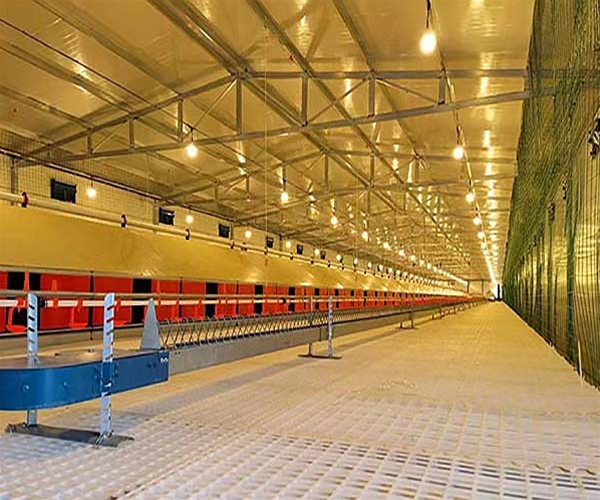In modern poultry farming, effective management of poultry houses is essential for ensuring healthy chickens and high production. By controlling temperature, humidity, ventilation, stocking density, lighting, and more, farmers can create the perfect environment for chickens to thrive. In this article, we will go over the key management factors that improve efficiency and reduce risks.
1. Poultry Management——Temperature Control: Creating a Healthy Environment
Chickens grow best when kept at the right temperature. For chicks, the ideal temperature is around 35°C for the first week. After that, you can lower the temperature by 1°C every three days. Experienced farmers watch the chickens’ behavior to adjust the temperature—if it’s too hot, the chickens will breathe heavily and spread their wings; if it’s too cold, they will huddle together and eat or drink less.
The management of temperature control equipment is crucial, so it is important to regularly check its operation to ensure the temperature in the poultry house remains constant and uniform, preventing stress or illness in the chickens caused by temperature fluctuations.
2. Poultry Management——Ventilation: Fresh Air for Healthier Chickens
Good ventilation is vital in poultry farming. The goal is to remove harmful gases like ammonia and carbon dioxide while bringing in fresh air. Poor ventilation can lead to poor air quality, which harms the chickens’ health and productivity.
Proper ventilation helps maintain an ideal temperature and air quality inside the poultry house, reducing the risk of disease and stress for the chickens.
3. Poultry Management——Humidity Control: Avoiding Too Dry or Too Damp Conditions
Humidity is also important. If the air is too dry (below 40%), chicks may become dehydrated, and adult chickens can develop dry skin and poor feather quality. If the humidity is too high (over 70%), the poultry house can become damp, leading to dirty feathers and increased risk of diseases.
For chickens in the early stages, humidity should be kept between 70-75%, and for adult chickens, it should be around 60-65%.
4. Poultry Management——Stocking Density: Give Chickens Enough Space
Stocking density is about making sure chickens have enough space to move around. In winter, farmers can start with one-third of the house for chicks, and gradually increase the space as the chickens grow. In the warmer months, it’s important to allow for more space to help chickens grow better.
Proper density management helps reduce disease spread and ensures chickens can eat, drink, and grow comfortably.
5. Bedding: Keeping the House Clean
Bedding is essential for a clean and healthy environment. Rice husks are commonly used because they help absorb moisture and reduce the buildup of ammonia. Farmers should regularly turn the bedding to keep it fresh and airy.
Bedding management is crucial for reducing odors and maintaining a healthy atmosphere in the poultry house.
6. Lighting: Help Chickens Adapt and Grow
New chicks need 24-hour lighting for the first three days to help them adapt. After that, you can reduce the lighting, but it shouldn’t be too dim, as it can affect their feeding. Proper lighting encourages chickens to eat and grow efficiently.
Lighting control is important for promoting healthy growth and higher feed intake.
7. Disinfection: Preventing Disease
Regular disinfection is essential to prevent disease. This includes cleaning both the inside and outside of the poultry house, as well as disinfecting the chickens themselves, especially the air inside.
Disinfection management helps keep harmful bacteria and diseases away, ensuring the health of the flock.
8. Water Management: Clean Water for Healthy Chickens
Water quality is crucial for chicken health. When chicks arrive, allow them to rest for about 30 minutes before giving them water. The water temperature should be around 25°C. Make sure the water is clean and free from bacteria.
Regularly check the water system to ensure there are no blockages or leaks in the water lines, so the chickens always have access to fresh, clean water.
9. Feeding: Timing is Key
Feeding should not be done too early. It’s best to wait around 18 hours after chicks hatch before offering feed, to allow them to absorb the yolk. Modern poultry houses usually offer free feeding, but farmers should still monitor the chickens to ensure they are eating regularly.
Proper feeding timing helps improve the absorption of nutrients and ensures healthy growth.
Conclusion
Standardized poultry house management is about creating the best possible environment for your chickens. By managing temperature, humidity, ventilation, stocking density, and lighting properly, farmers can ensure the health of their chickens and improve overall production.
If you’re looking for efficient poultry management equipment, Shohhui offers a range of smart devices designed to help boost your farm’s productivity and efficiency. Contact us today to learn more!


